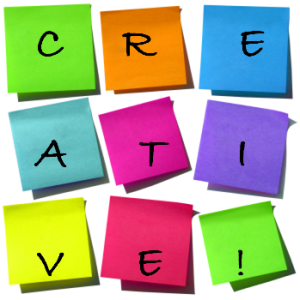Creativity: Can Creativity Be Learned?

It’s time to think again.
First, let’s address 2 myths: ‘Creativity is for artistic people’ and ‘You’re either born creative or not’.
Wrong and Wrong.
Creativity is not just devolved to artists and designers. Anyone can be creative…. in any field.
Let me rephrase this: Anyone should be creative.
Have you ever heard of creative accounting? When you think accounting, creativity is not the first thing that comes to mind and yet creative accounting explores loopholes and saves money.
Creativity can be applied to any field to help find new ways of doing things, solving problems, cutting costs, convincing people,…
What if you’re just not creative?
Well, there’s no such thing as not being creative. Everyone is creative to some extent. Often, creativity has been repressed at school by what and how we’ve learned. Remember just how inhibited your thoughts were as a child.
So here are 4 tips to reclaim some of this lost creativity.
1 – Adopt A Creative Positive Attitude
A negative attitude will block creativity.
‘There’s no solution’. ‘I’m not creative’. ‘There’s nothing I can do’.
Forget all that!
- When you’re presented with a question or a problem, there’s not just one good answer. You can create lots of answers. If they work, they’re good.
- Be curious, ask questions, why? why is it like this? why not like that?
- Challenge the way things have always been done.
- Is there a way to do things better?
- Welcome problems as opportunities to improve the way things are done.
- Don’t be scared to reuse the good features of a bad solution to create a new good solution. When Spencer Silver of 3M tried to create a very strong glue for planes, he produced a failure: an incredible weak glue. Yet this glue had certain interesting properties. When stuck to a surface it could be peeled away without leaving residues and it could be re-used. After several years, a new use for the glue was found: post-it notes, now one of the top 5 office supply best-sellers in the world.

2 – Give Your Problem Limits
This one seems counter-intuitive. You’d think widening the area of research would help unleash creativity. But let’s do a quick test.
If I ask you to to create some new gym equipment, any at all. Pause for a second and try to come up with something.
Did you get anything? Was it easy?
Now, if I ask you to create some new equipment that you can use while seating in your car as a passenger. Can you feel ideas coming?
Restricting the field of your brief gives some ideas to your brain to work with, to start from, to explore, to bounce off from. It makes your lateral thinking working, the one that can transpose and adapt one idea to another context. Of course, you don’t want to restrict things too much otherwise it will kill any exploratory idea. But playing with restrictions and constraints will help your creativity rather than hinder it.

3 – Forget What You Think You Already Know
The more experience we have, the more set in our ways we become. We’ve had years of being told ‘No’ and we don’t bother asking anymore. Faced with new problems, we more than likely assume pre-conceived constraints and we don’t even bother exploring certain solutions. Whereas freshman students and amateurs would just ask questions and push boundaries without even worrying about it.
Here are some solutions that wouldn’t come to mind if we remained set in our ways:
- Using superglue to connect sections of a car with more ease and strength than using rivets. There are many kinds of glue, and the kind used to stick car parts together makes a bond stronger than the metal of the parts themselves.
- Using plastic to make lighter weight bullet proof windows. Some plastics are not flimsy at all and are used in place of steel and in bullet proof windows.
- Using light concrete to make a ship’s hull that won’t rust or rot like steel or wood.

4 – Use Your Right Brain
There seems to be a difference between the brain activity of creative and non creative people, according to this right brain research.
Creative people show more right brain activity than non-creative people when asked to solve problems. The right brain plays a ‘special role in solving problems with creative insight, likely due to right-hemisphere involvement in the processing of loose or “remote” associations between the elements of a problem, which is understood to be an important component of creative thought’
Whereas non-creative people face problems with a more methodical approach, creative people make associations, use lateral thinking and often come across an ‘Aha moment’.
I am a great believer in brain plasticity. The more we use our brain in certain ways, the more we shape it. We’ve already written about it in our article Everyday Stretch Routine For The Brain.
Here are some methods to get you started:
- Incremental improvement method: Can you take something that exists and make it slightly better?
- Associative method: can you draw connections between ideas from different fields to combine them into a new idea?
- Revolution method: can you challenge traditional wisdom with a completely different tack to the problem?
- Reapplication method: can you see beyond the traditional uses of a product to create new applications?
Even when you’re not faced with problems, learn to observe what’s happening around you. Try and spot new ways of doing things. Meet with people with different ideas and perspectives. Keep the creative juices flowing!
Further Thoughts
Yes, creativity can be learned and fostered and applied to any activity.
Learning creativity is a process. You learn a new way of thinking. You learn to experiment, explore, question assumptions, use your imagination, synthesize information.
Like a sportsman, it takes practice.
But it’s worth it.



Comments
Creativity: Can Creativity Be Learned? — No Comments
HTML tags allowed in your comment: <a href="" title=""> <abbr title=""> <acronym title=""> <b> <blockquote cite=""> <cite> <code> <del datetime=""> <em> <i> <q cite=""> <s> <strike> <strong>